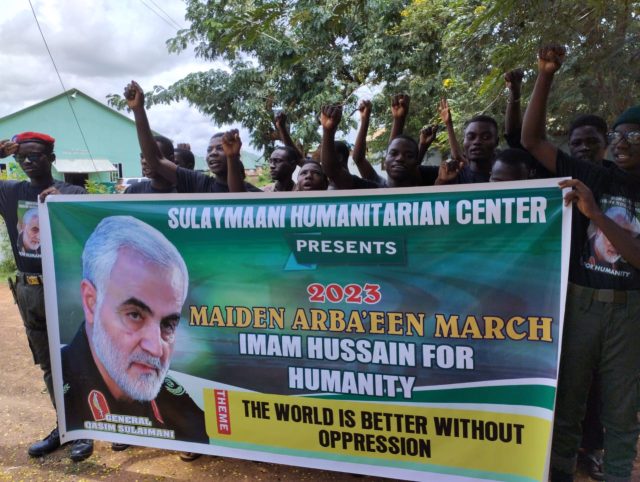The Suleymani humanitarian center in Tamale held their maiden Arba’een (40th day after the martyrdom of imam Hussein) March on Friday the 15th under heavy rains and continued into Saturday the 16th of September 2023.
Attendance at the procession was very much encouraging for a maiden event. The theme of the procession was: “Imam Hussein for Humanity. The World is Better Without Oppression”
The main message at the procession happened to be the message of Ayatollah Sayyid Ali Khamenei which he delivered some 49 years ago to mark The Arba’een procession of that year. The text of his message is as fellows:
“The text of His Eminence’s statements is as follows:
“Do you know one of the signs of faith is the visitation (travelling to Karbala-Iraq, in honor of Imam Hussein (a.s), also known as Ziyaratul Arbaeen) of Arbaeen? I don’t know how accurate this narration is. I don’t insist that the meaning I have deduced from it is the only one, that’s just my interpretation. The real meaning might be one of the gaps or other possibilities that have been expressed in this regard. But even if the possibility I’m suggesting is considered, it has strong support: ‘The visitation of Arbaeen.’”
“The Shia were a scattered community, a society that didn’t live in one place; they were in Medina, Kufa, Basra, Ahvaz, Qom, Khorasan—all around and the outskirts of regions. But there was a spirit flowing through this dispersed body and these fragmented parts, like the beads of a rosary, a thread connecting them. What was that thread? The thread of obedience and loyalty to the central leadership of Shia, the supreme leadership of Shia, namely the Imam; all these beads were connected by it. It was a heart that gave orders to all members. Thus, Shia was an organization and an institution. Two individuals might not know each other’s condition, but there were those who knew about everyone. Their obedience and loyalty were calculated, their shouting was according to orders, their silence according to a plan, everything was calculated. Their only flaw was that they saw each other less.
People from the same city and Shia from the same region, of course, saw each other, but a global congress was necessary for the Shia of the era of the Imams (peace be upon them). They designated this global congress, set the time for it; they said on this specified date, in that congress, everyone can participate. That time is Arbaeen, and the place for participation is the land of Karbala. Because the soul of Shia is the soul of Karbala, the soul of Ashura; the pulse of the Day of Ashura is visible in the body of Shia; wherever Shia exists, it follows the path of Husseini Ashura. That’s why we see these pulses that have been revealed in Shia, they originate from that holy shrine; these flames are ignited by that sacred and pure spirit, by that elevated tomb. They have ignited souls; they have turned humans into burning bullets, aimed at the heart of the enemy.”
“The first movement that emerged among the Shia after Husseini Ashura was the movement of ‘Tawwabin’ (those who repent). They gathered around that holy shrine, as historical records have written, shedding numerous tears. Some think this crying and shedding of tears is a means of catharsis. Yes, crying and shedding tears are a means of catharsis if not accompanied by thinking. If crying and shedding tears only direct emotions, that’s what they say. However, if tears are prompted by thought and reflection, and a person sheds a tear drop from their eyes due to their thoughts and ideas, this is like the barbecue skewer that makes the fire sharper and more intense.
It’s not catharsis; it’s a weapon. That’s why crying is among the foremost activities of the exemplary Shia, all of whom were in the path of resistance, all were stepping on the path of Ashura. Imam Ja’far Sadiq is a crier; Imam Reza (peace be upon him) is a crier. They force the poets to recite these epic poems, to gather groups and make them weep over the past of Shia, because with this crying, their fire becomes more blazing and flares up. The Tawwabin came; they shed copious tears, whatever you want. I think I’ve said that it was one night or two nights—written in historical records, I’ve forgotten—they shed tears; then after these tears, they decided to offer their lives in the way of God, and before being killed, not to put down their weapons, and not to return from this battle alive.
That’s what happened. Great individuals; Salman ibn Sad Khaza’i, the companion of Amir al-Mu’minin (peace be upon him), a disciple of Imam Hasan—people like these went, and there they gave their lives and were killed. The beginning was in Karbala; see how this reality has manifested in that era, how it was evident and conspicuous! In our people’s minds today, however, this reality, of course, no longer retains that beauty and splendor; it’s different. Therefore, the issue of Arbaeen is an important matter.”
“Arbaeen means the gathering of Shia in an international congress, a global congress, in a land that itself is memorable; a land of memories, splendid memories, great memories; the land of martyrs, the graves of those who were killed in the way of God. They gather there, the followers of Shia, and they strengthen the ties of brotherhood and loyalty even more. This is Arbaeen.”
“Other than the repentant, we also have those who came there and benefited from it. One of the greatest movements of Shia in the era of the Abbasid Caliphs is the movement of ‘Ibn Tabataba’i,’ these honorable Sayyids are apparently from the descendants of that Muhammad ibn Ibrahim ibn Isma’il Tabataba’i. This Muhammad ibn Ibrahim ibn Isma’il Tabataba’i initiated a strange movement, they achieved victory and captured a significant part of the Islamic world, establishing the rule of Shia and Alawites, contrary to those who think that such a right was not given to the Imams.
No, this right was given to them; they were authorized by their superiors, and they succeeded; however, these gentlemen became ill and passed away, and this became a means for the loss of that success and triumph. After a few years, of course, the movement was defeated. But they were active for some years. When these gentlemen wanted to start, they came to Karbala. Those who wanted to start, along with Abu al-Saraya and all the Shia who were with them, came to Karbala, and they pledged brotherhood and loyalty beside the grave of Hussein ibn Ali (peace be upon him).”
“Of course, you’ve heard that Jabir ibn Abdullah al-Ansari also came. In my opinion, this honorable individual is the third person who has come to visit the grave of Hussein ibn Ali (peace be upon him). The third group that came for the visitation was Jabir and Atiyyah. Before them, some people had come for the visitation. Maybe the first people to visit this sacred tomb were the Bani Asad, who came to bury the holy remains of Hussein ibn Ali (peace be upon him); they were the first to visit this tomb. Jabir also came to visit, as you have heard with those details that were spoken there at the grave, which gentlemen [usually] mention; it has been heard in gatherings and forums and you’ve heard it before.”
“In summary, the commemoration of Ashura, the memory of that jihad, self-sacrifice, and great selflessness, takes place on the day of Arbaeen; and in that land. If today they can turn that pure and sacred land into such a rendezvous for the Shia, it will indeed be a significant and interesting task, and it’s following the path that the Imams of guidance (peace be upon them) have shown us.”
Labaika Yaa Hussein

















